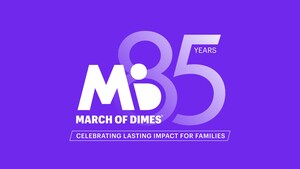Fertility Drugs Contribute Heavily to Multiple Births
March of Dimes Concerned About Drugs' Role in Crisis of Prematurity
WHITE PLAINS, N.Y., June 16 /PRNewswire-USNewswire/ -- The widespread use of fertility drugs, not just high-tech laboratory procedures, plays a major role in causing multiple births and contributes to the problem of premature birth in the United States, experts said today at the March of Dimes National Communications Advisory Council luncheon.
Working with experts from the U.S. Centers for Disease Control and Prevention (CDC), Joann Petrini, PhD, assistant director of research at Danbury Hospital in Connecticut and an advisor to the March of Dimes, found that controlled ovarian hyperstimulation (COH) drugs — which are used to stimulate a woman's ovaries to speed the maturity and multiply the production of eggs — account for four times more live births than assisted reproductive technologies (ARTs) such as in vitro fertilization.
"Many people have focused on the role of ARTs in multiples and have not fully appreciated that fertility drugs alone are responsible for one out of every five multiple births," said Dr. Petrini. "There is a very high possibility of multi-fetal pregnancy resulting from these drugs, and that brings a high risk of prematurity and lifelong health problems for the babies as a consequence."
Patients should inform their doctors that their goal is a single baby and that they wish them to use treatments that minimize the risk of multiple pregnancy, said Richard Dickey, MD, PhD, medical director of The Fertility Institute of New Orleans and Clinical Professor of Obstetrics and Gynecology at the Louisiana State University Health Sciences School of Medicine at New Orleans.
"A doctor's goal when prescribing fertility drugs is one healthy baby," said Dr. Dickey. "Doctors should not hesitate to cancel ovulation stimulation cycles and to tell their patients to avoid trying to get pregnant if an ultrasound shows there are too many eggs present in a cycle and the risk of multiples is high. "The March of Dimes urges more research and leadership from professional societies to develop specific guidelines and encourage acceptance of best practices for the proper use and dosage of fertility drugs, as well as the careful counseling and monitoring of women treated with these drugs. Also, the March of Dimes said a system is needed to monitor how many multiples births are caused by fertility drugs and to hold professionals accountable to industry guidelines. Women who are taking fertility drugs should always ask their doctor what they can do to prevent having a multi-fetal pregnancy.
About 88,000 babies are born preterm annually as a result of the recent increase of twins, triplets, and other multiple births. About 60 percent of twins, more than 90 percent of triplets and virtually all quadruplets and higher-order multiples are born prematurely. In addition to the increased risks associated with multiple birth, studies have also suggested that even infants born singly but conceived with ovulation stimulation are at increased risk for preterm birth than naturally conceived single births, the study authors pointed out.
The March of Dimes said it is critical for the American Society for Reproductive Medicine, the American College of Obstetricians and Gynecologists, and other clinical societies to develop clear guidelines on the use of fertility drugs to help prevent many premature births.
More than 540,000 babies are born too soon each year in the United States. Preterm birth costs the nation more than $26 billion annually, according to the Institute of Medicine. It is the leading cause of newborn death, and babies who survive an early birth face the risk of lifelong health problems, such as breathing problems, mental retardation, cerebral palsy, developmental delays, and vision and hearing loss. Even babies born just a few weeks too soon (34-36 weeks gestation, also known as late preterm birth) have higher rates of death and disability than full-term babies.
The March of Dimes is the leading nonprofit organization for pregnancy and baby health. With chapters nationwide, the March of Dimes works to improve the health of babies by preventing birth defects, premature birth and infant mortality. For the latest resources and information, visit marchofdimes.com or nacersano.org. For free access to national, state, county and city-level maternal and infant health data, visit PeriStats, at marchofdimes.com/PeriStats.
SOURCE March of Dimes
WANT YOUR COMPANY'S NEWS FEATURED ON PRNEWSWIRE.COM?
Newsrooms &
Influencers
Digital Media
Outlets
Journalists
Opted In





Share this article